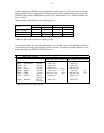-21-
T-1 (DS1) SERVICE
OVERVIEW AND OPERATIONS
The goal of the T-1 (DS1) section is to present basic information about T- 1 networking, what it is, how it
operates, and what it means to the customer. The section does not explain how the MERLIN LEGEND
Communications System interfaces with ISDN-PRI.
Further, this Note does not cover the indepth details of signaling and encoding on which T-1 service is
based. Instead the focus is on giving an overview of how T-1 fits into the telecommunications needs of
customers.
T-1 signifies a virtual revolution in how analog and digital signals are sent over a network.
It provides a two-way connection at 1,544,000 bits per second. This can be stated as 1.544 Megabits per
second (Mbs), which is also called “digital signal level one” (DS1). Generally the designation “T-1” means
any transmission line or connection running at 1.544 Mbit/s. In a stricter sense, T-1 is applied to the system
of copper wire cables and amplifiers or regenerators that reinforce the digital signal at intervals of
approximately one mile.
AT&T, telephone companies, and other interconnect companies all provide T-1 service. Also, a very large
customer may own its own T-1 system. A system can be made up of copper wire cables, microwave.
optical fiber, or other media. It is not unusual for three or more carriers using various media to be involved
in providing T- 1 service to a customer. Often it can be as many as six or eight carriers.
The standard T-1 line consists of 24 channels. One T-1 line replaces 24 of the voice grade analog copper
wire pairs known as 3002 lines. One T-1 can also transport 150 data channels; each would need a full voice
grade line on the analog network. To be most economical, T-1 transmission can combine voice and data
signals simultaneously.
If a customer connects to AT&T, the customer premises PBX must be compatible with a 4ESS (Generic 13
or higher) toll office switch. If the connection is to the telephone company, the PBX must be compatible
with the telco 5ESS central office switch. (The MERLIN LEGEND CS is certified for use with the AT&T
4ESS switch and the 5ESS switch for T-1 service.) It is possible to get fractional T-1 (FT1) service from
most T-1 providers where the user can designate time slots for sending and receiving by using only part of
the 24 circuits available in a T-1 link. The availability of FT1 will be of special interest to many GBS
customers. If customers have six or more circuits of any kind, fractional T-1 is likely to be more
economical.
To understand better the use of T-1 it’s necessary to appreciate the advantages that T-1 offers to the
communications system operator. These may be headed under the broad categories of Network Control,
Reliability, and Quality.
When telecommunications was solely dependent upon the use of voice grade 3002 lines, it was necessary to
know weeks (or even months) in advance when a user would require a change in the way network lines
were being used. It usually took that long for the telephone company to make the
rearrangement. With T-1
service one of the major Network Controls the user gains is the quick ability to configure the system within
minutes. The network manager reassigns the channel resources where they are needed to meet changing
daily business requirements, emergencies, or to improve productivity.
Another Network control that is of vital user interest is diagnostic control. With the system split between
half a dozen carriers, it is necessary to be able to monitor the various parts on a continuing basis. This
means the user has the ability to locate faults and quickly get the proper maintenance group to restore


















